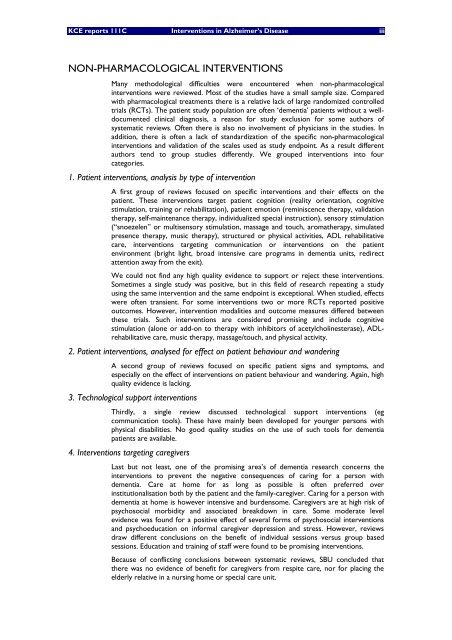Download the full report (112 p.) - KCE
Download the full report (112 p.) - KCE
Download the full report (112 p.) - KCE
You also want an ePaper? Increase the reach of your titles
YUMPU automatically turns print PDFs into web optimized ePapers that Google loves.
<strong>KCE</strong> <strong>report</strong>s 111C Interventions in Alzheimer’s Disease iii<br />
NON-PHARMACOLOGICAL INTERVENTIONS<br />
Many methodological difficulties were encountered when non-pharmacological<br />
interventions were reviewed. Most of <strong>the</strong> studies have a small sample size. Compared<br />
with pharmacological treatments <strong>the</strong>re is a relative lack of large randomized controlled<br />
trials (RCTs). The patient study population are often ‘dementia’ patients without a welldocumented<br />
clinical diagnosis, a reason for study exclusion for some authors of<br />
systematic reviews. Often <strong>the</strong>re is also no involvement of physicians in <strong>the</strong> studies. In<br />
addition, <strong>the</strong>re is often a lack of standardization of <strong>the</strong> specific non-pharmacological<br />
interventions and validation of <strong>the</strong> scales used as study endpoint. As a result different<br />
authors tend to group studies differently. We grouped interventions into four<br />
categories.<br />
1. Patient interventions, analysis by type of intervention<br />
A first group of reviews focused on specific interventions and <strong>the</strong>ir effects on <strong>the</strong><br />
patient. These interventions target patient cognition (reality orientation, cognitive<br />
stimulation, training or rehabilitation), patient emotion (reminiscence <strong>the</strong>rapy, validation<br />
<strong>the</strong>rapy, self-maintenance <strong>the</strong>rapy, individualized special instruction), sensory stimulation<br />
(“snoezelen” or multisensory stimulation, massage and touch, aroma<strong>the</strong>rapy, simulated<br />
presence <strong>the</strong>rapy, music <strong>the</strong>rapy), structured or physical activities, ADL rehabilitative<br />
care, interventions targeting communication or interventions on <strong>the</strong> patient<br />
environment (bright light, broad intensive care programs in dementia units, redirect<br />
attention away from <strong>the</strong> exit).<br />
We could not find any high quality evidence to support or reject <strong>the</strong>se interventions.<br />
Sometimes a single study was positive, but in this field of research repeating a study<br />
using <strong>the</strong> same intervention and <strong>the</strong> same endpoint is exceptional. When studied, effects<br />
were often transient. For some interventions two or more RCTs <strong>report</strong>ed positive<br />
outcomes. However, intervention modalities and outcome measures differed between<br />
<strong>the</strong>se trials. Such interventions are considered promising and include cognitive<br />
stimulation (alone or add-on to <strong>the</strong>rapy with inhibitors of acetylcholinesterase), ADLrehabilitative<br />
care, music <strong>the</strong>rapy, massage/touch, and physical activity.<br />
2. Patient interventions, analysed for effect on patient behaviour and wandering<br />
A second group of reviews focused on specific patient signs and symptoms, and<br />
especially on <strong>the</strong> effect of interventions on patient behaviour and wandering. Again, high<br />
quality evidence is lacking.<br />
3. Technological support interventions<br />
Thirdly, a single review discussed technological support interventions (eg<br />
communication tools). These have mainly been developed for younger persons with<br />
physical disabilities. No good quality studies on <strong>the</strong> use of such tools for dementia<br />
patients are available.<br />
4. Interventions targeting caregivers<br />
Last but not least, one of <strong>the</strong> promising area’s of dementia research concerns <strong>the</strong><br />
interventions to prevent <strong>the</strong> negative consequences of caring for a person with<br />
dementia. Care at home for as long as possible is often preferred over<br />
institutionalisation both by <strong>the</strong> patient and <strong>the</strong> family-caregiver. Caring for a person with<br />
dementia at home is however intensive and burdensome. Caregivers are at high risk of<br />
psychosocial morbidity and associated breakdown in care. Some moderate level<br />
evidence was found for a positive effect of several forms of psychosocial interventions<br />
and psychoeducation on informal caregiver depression and stress. However, reviews<br />
draw different conclusions on <strong>the</strong> benefit of individual sessions versus group based<br />
sessions. Education and training of staff were found to be promising interventions.<br />
Because of conflicting conclusions between systematic reviews, SBU concluded that<br />
<strong>the</strong>re was no evidence of benefit for caregivers from respite care, nor for placing <strong>the</strong><br />
elderly relative in a nursing home or special care unit.

















